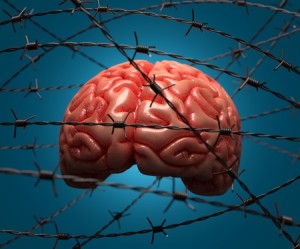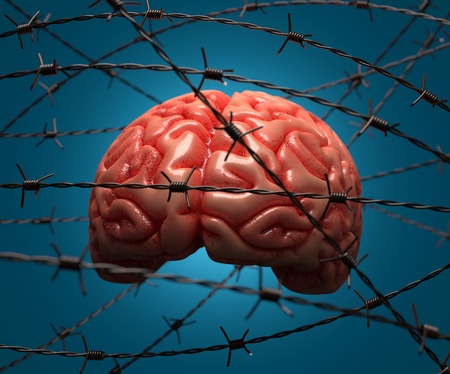
Danielle Egan opened her article for Mad in America on the adverse effects of deep brain stimulation (DBS) with a quote from a DBS patient named Jim: “I just want the thing out. . . . It could be harming my brain and it’s certainly doing a lot of psychological harm to me. It’s a very real presence and I can feel the wires under my skull and at my neck. After two years of this, I just want to be done with it.” Jim is one of around 272 people worldwide who have had these experimental implants to treat psychiatric disorders such as depression, OCD and Tourette’s syndrome.
Egan has been investigating DBS and writing about individuals who have had the surgery for a number of years. Jim is just one of several people she’s met and interviewed. You can read about several of these individuals on her website under the “neuroscience” heading of her blog. The first DBS surgical procedure for depression occurred in 2003. It has been used and approved previously as a treatment for movement disorders like Parkinson’s. At first, the news about this technique was almost wildly positive. See “Deep Brain Jolts.”
In a 2005 interview for the NPR program “All Things Considered,” Dr. Helen Mayberg, reported that four out of six patients were relieved of intractable depression with her DBS procedure. “At six months, the four patients that responded to this treatment were actually near remission … meaning they weren’t just better, they were well.” Mayberg and her research colleagues reported their finding in the March 2005 issue of Neuron. Reporting on Mayberg’s research for Scientific American, John Horgan attended a lecture she gave in March of 2014 where she was still describing promising results. But according to Horgan, she “buried the lead” by mentioning midway through her talk that a multi-center trial of her method of DBS had been halted by the FDA.
This meant that the FDA suspended the BROADEN trial because it failed a “futility analysis,” meaning it did not appear to have a reasonable chance of improving upon current treatments.
As Egan related in her article, advocates of DBS still have no clear sense of what its mechanism of “therapeutic” action is, even though it has been studied since the 1980s. When treating depression, Mayberg’s method targets an area of the brain known as the subgenual cingulate gyrus (Cg25). In theory, DBS is reversible; so it was thought to be a better way to inhibit brain activity than the permanent lesions of psychosurgery. But so-called “micro-lesions” from the surgery and the DBS implants have been found. Long-term studies of Parkinson’s patients treated with DBS have shown they have DBS-related scar formation in their brains. There have been serious mood, behavior and personality changes documented as well.
These include suicide, depression, apathy, fatigue, mania and serious impulse control issues, such as hypomania, aggression, addiction (to gambling, shopping, drugs, alcohol) and hypersexuality, sometimes resulting in criminal behaviour, including pedophilia.
Because of the area of the brain targeted by DBS treatment for psychiatric disorders, the cerebral cortex, the risks are likely to be more pronounced than with Parkinson’s. Within the cerebral cortex are a variety of cognitive functions, such as learning, sorting and rationalizing input from the inner and outer world. It is also the seat of human personality, with associations to mood, decision-making, impulse control and other behaviors. The Cg25 area is also thought to be linked to self-esteem, motivation, reward-based thoughts and moral decision-making. “Clinical studies have linked tissue damage in the Cg25 with disinhibition, which is associated with frontal lobe brain damage causing poor impulse control.”
Mayberg et al.’s 2005 study did post-operative PET scans showed decreased activity in the Cg25 area, which was believed to be a positive inhibiting effect. But blood flow increased in other areas, especially the brain stem, where mechanisms like heart rate, breathing anxiety and euphoria are regulated. Other studies have shown these blood flow changes to be connected to mania, dementia, psychosis and dissociation.
Returning to Jim, he had no idea that the sponsor of the BROADEN clinical trial he was in terminated it because it failed to reach a benchmark of a 50% response rate as measured by the Hamilton Depression Scale. Beside his cognitive issues, Jim had extreme sleep problems that began about six months post-implant. Eventually he sought out a sleep disorder specialist who diagnosed him with REM Behavior Disorder. This means the brain functions just as it does during consciousness, without the muscle paralysis that come with REM sleep.
“I’d have night terrors and catatonic sleep, like narcolepsy; it would just come over me in the middle of the day and I’d have 20 minutes to get somewhere safe before it took over and knocked me out; my wife couldn’t even wake me up. That happened four or five times per week.”
Eventually Jim returned to his study center to have the device turned off. His thinking began to clear up. His sleep problems almost disappeared. “But I want this thing out.” When he signed up for the trial, his consent from said that DBS was reversible by removing the implant. But when he registered for the followup study, its consent form said: “In some cases the device is not removable.” The complexity of the frontal cortex with its connection with so many other regions of the brain seems to be the reason. The surgeon explained that the leads (wires) from the device may be too tense and “they might have to leave them there.”
Jim had his “explant” surgery, a four-hour surgery instead of a routine one-and-a-half hour outpatient procedure. “I guess the surgeon had to do a bit of prying.” A part of the device that fits into the skull gave the surgeon trouble because bone and tissue had knitted together around it. His head was throbbing; as was the skin around where the pacemaker had been implanted in his chest. I feel like the DBS broke my brain; it broke something in me. . . . But I need to put what happened behind me. I’m just relieved it’s out.”
After John Horgan published his March 2014 story mentioned above, he was contacted by Steve Ogburn, who had also been a patient in the BROADEN trial. He quoted Steve as referring to himself as ‘colatteral damage’ from the study in a May 2014 article. Steve had his surgery at Stanford in November of 2012. He developed severe head pain three months into the study. The leads were 18 inches too long, and had been coiled up in his chest and the top of his head. He could feel them externally. He had “bowstringing” a condition where scar tissue forms around the leads. This has been documented in others DBS cases and can cause permanent complications. He had problems with shoulder and jaw muscle atrophy, spinal accessory nerve palsy and occipital nerve palsy. Steve is pursuing a lawsuit against St. Jude (the medical device company), Stanford University, Stanfords’s IRB (institutional review board), and the neurosurgeon who did the DBS implant. You can watch a 15-minute video of Steve telling his story. A link is embedded in Danielle Egan’s article and in Horgan’s May 2014 article.
In July of 2015 John Horgan reported on a second DBS clinical trial failure, now with the medical device developed by Medtronic. A team from Massachusetts General Hospital led by Darin Dougherty tested 30 subjects with treatment resistant depression; half received DBS and half received a placebo treatment. There was not a significant difference in response rates between the DBS and the placebo subjects. Dougherty said: “The bottom line is that we can’t separate out active treatment from placebo.”
“The Dr. Peter Breggin Hour” podcast for 9.30.15 was a conversation between Peter Breggin and Danielle Egan on many of the issues discussed here and covered in her Mad in America article. The podcast is also available free through iTunes. Egan said in the podcast that after she learned of the original Canadian trial study conducted by Dr. Mayberg (before she went from Canada to Emory University in Atlanta), she tried repeatedly to contact the individuals involved in the Canadian study with no success. It was only in 2015 after Steve Ogburn helped, was she able to interview some of those individuals.
DBS is not going away, despite what is reported here. Emory University published a press release touting the positive results of Mayberg’s continued research with DBS. A woman has a new life, “After three decades of severe depression and trying nearly every treatment, deep brain stimulation helped [her] reclaim her life and regain the ability to feel joy.” Horgan noted that the press release didn’t mention the two failed DBS clinical trials.





